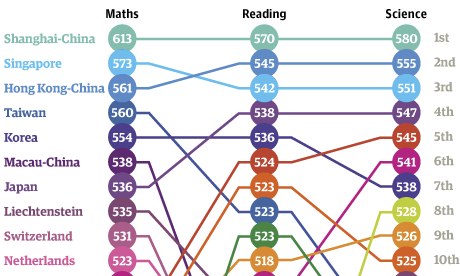 Graphic: OECD-PISA
Graphic: OECD-PISA
The results for the 2012 Program For International Student Assessment (PISA) testing were issued in early December 2013, and the top seven places are held by Asian countries/economies.
The PISA program is sponsored by the Organization for Economic Cooperation and Development headquartered in Paris. PISA conducts a:
“Triennial international survey which aims to evaluate education systems worldwide by testing the skills and knowledge of 15-year-old students.” (OECD-PISA Website)
The tests in Reading, Mathematics and Science are unique in that they are:
- Not linked to any school curriculum
- Test knowledge for use in real-life situations
- Try to assess students’ ability to participate in society
“Rather than examine mastery of specific school curricula, PISA looks at students’ abilities to apply knowledge and skills in key subject areas and to analyse, reason and communicate effectively as they examine, interpret and solve problems.” (OECD-PISA Website)
The top seven countries/economies in 2012 were Shanghai, Singapore, Hong Kong, Taiwan Korea, Macau and Japan.
China’s Ministry of Education declined to participate in 2012, but is on board for testing 2015.
Of interest is the fact that many believe that Asian education is strictly by rote, and hence does not create creative thinkers. Yet the test criteria does not call for the simple repetition of learned material, but requires the application of learned material in a real-world type situation.
The tests, which began in 2000, and are held every three years, were taken in 2012 by more than 500,000 students in 70 countries and economies worldwide.
PISA website: http://www.oecd.org/pisa/
 日本語
日本語 English
English 中国語
中国語